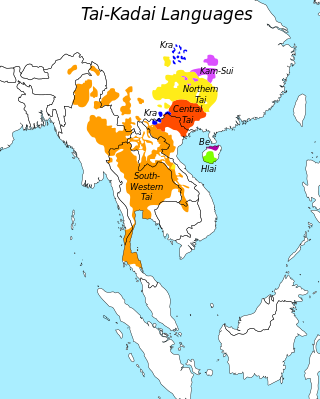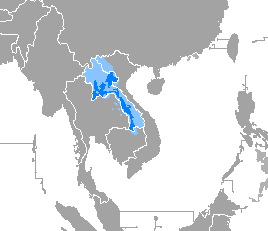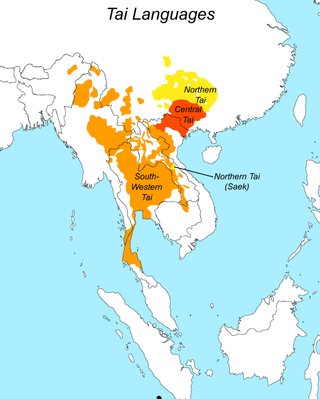
The Kra–Dai languages, are a language family in mainland Southeast Asia, southern China, and northeastern India. All languages in the family are tonal, including Thai and Lao, the national languages of Thailand and Laos, respectively. Around 93 million people speak Kra–Dai languages; 60% of those speak Thai. Ethnologue lists 95 languages in the family, with 62 of these being in the Tai branch.

Lao, sometimes referred to as Laotian, is the official language of Laos and a significant language in the Isan region of northeastern Thailand, where it is usually referred to as the Isan language. Spoken by over 3 million people in Laos and 3.2 million in all countries, it serves as a vital link in the cultural and social fabric of these areas. It is written in the Lao script, an abugida that evolved from ancient Tai scripts.

The Shan people, also known as the Tai Long or Tai Yai, are a Tai ethnic group of Southeast Asia. The Shan are the biggest minority of Burma (Myanmar) and primarily live in the Shan State of this country, but also inhabit parts of Mandalay Region, Kachin State, Kayah State, Sagaing Region and Kayin State, and in adjacent regions of China, Laos, Assam and Meghalaya, Cambodia, Vietnam and Thailand. Though no reliable census has been taken in Burma since 1935, the Shan are estimated to number 4–6 million, with CIA Factbook giving an estimate of five million spread throughout Myanmar which is about 10% of the overall Burmese population.

The term Kra–Dai peoples or Kra–Dai-speaking peoples refers collectively to the ethnic groups of southern China and Southeast Asia, stretching from Hainan to Northeast India and from southern Sichuan to Laos, Thailand and parts of Vietnam, who not only speak languages belonging to the Kra–Dai language family, but also share similar traditions, culture and ancestry.

Kam Mueang or Northern Thailanguage is the language of the Northern Thai people of Lanna, Thailand. It is a Southwestern Tai language that is closely related to Tai Lue language. Kam Mueang has approximately six million speakers, most of whom live in the native Northern Thailand, with a smaller community of Lanna speakers in northwestern Laos.

The Tai, Zhuang–Tai, or Daic languages are a branch of the Kra–Dai language family. The Tai languages include the most widely spoken of the Tai–Kadai languages, including Standard Thai or Siamese, the national language of Thailand; Lao or Laotian, the national language of Laos; Myanmar's Shan language; and Zhuang, a major language in the Southwestern China's Guangxi Zhuang Autonomous Region, spoken by the Zhuang people (壯), the largest minority ethnic group in China, with a population of 15.55 million, living mainly in Guangxi, the rest scattered across Yunnan, Guangdong, Guizhou and Hunan provinces.

The Shan language is the native language of the Shan people and is mostly spoken in Shan State, Myanmar. It is also spoken in pockets in other parts of Myanmar, in Northern Thailand, in Yunnan, in Laos, in Cambodia, in Vietnam and decreasingly in Assam and Meghalaya. Shan is a member of the Tai–Kadai language family and is related to Thai. It has five tones, which do not correspond exactly to Thai tones, plus a sixth tone used for emphasis. The term Shan is also used for related Northwestern Tai languages, and it is called Tai Yai or Tai Long in other Tai languages. Standard Shan, which is also known as Tachileik Shan, is based on the dialect of the city of Tachileik.
Southern Thai, also known as Dambro, Pak Tai, or "Southern language", is a Southwestern Tai ethnolinguistic identity and language spoken in southern Thailand as well as by small communities in the northernmost Malaysian states. It is spoken by roughly five million people, and as a second language by the 1.5 million speakers of Pattani and other ethnic groups such as the local Peranakans communities, Negritos, and other tribal groups. Most speakers are also fluent in or understand the Central Thai dialects.
Tai Lue or Xishuangbanna Dai is a Tai language of the Lu people, spoken by about 700,000 people in Southeast Asia. This includes 280,000 people in China (Yunnan), 200,000 in Burma, 134,000 in Laos, 83,000 in Thailand and 4,960 in Vietnam. The language is similar to other Tai languages and is closely related to Kham Mueang or Tai Yuan, which is also known as Northern Thai language. In Yunnan, it is spoken in all of Xishuangbanna Dai Autonomous Prefecture, as well as Jiangcheng Hani and Yi Autonomous County in Pu'er City.
Tai Dam, also known as Black Tai, is a Tai language spoken by the Tai Dam in Vietnam, Laos, Thailand, and China.
Mueang, Muang, Mong, Meng or Mường (Vietnamese) were pre-modern semi-independent city-states or principalities in mainland Southeast Asia, adjacent regions of Northeast India and Southern China, including what is now Thailand, Laos, Burma, Cambodia, parts of northern Vietnam, southern Yunnan, western Guangxi and Assam.
The Tai Le script, or Dehong Dai script, is a Brahmic script used to write the Tai Nüa language spoken by the Tai Nua people of south-central Yunnan, China. It is written in horizontal lines from left to right, with spaces only between clauses and sentences.
Zuojiang Zhuang is a dialect-bund in Zhuang languages spoken along the Zuo River, including the counties of Tiandeng, Daxin, Chongzuo, Ningming, Longzhou, and Pingxiang in Guangxi, some villages in Funing in Yunnan, and Vietnam, and is a putative branch of Tai languages of China and Vietnam. Also known as Tho.
Proto-Tai is the reconstructed proto-language of all the Tai languages, including modern Lao, Shan, Tai Lü, Tai Dam, Ahom, Northern Thai, Standard Thai, Bouyei, and Zhuang. The Proto-Tai language is not directly attested by any surviving texts, but has been reconstructed using the comparative method.

Tai peoples are the populations who speak the Tai languages. There are a total of about 93 million people of Tai ancestry worldwide, with the largest ethnic groups being Dai, Thais, Isan, Tai Yai (Shan),Tai Lai (Shanni), Lao, Tai Ahom, Tai Meitei and Northern Thai peoples.

The Northern Tai languages are an established branch of the Tai languages of Southeast Asia. They include the northern Zhuang languages and Bouyei of China, Tai Mène of Laos and Yoy of Thailand.
Sapa, or Tày Sa Pa, is a Southwestern Tai language of Sa Pa, Lào Cai Province, northern Vietnam. According to Pittayaporn (2009) and Glottolog, it is the closest relative of the Southwestern Tai languages, but does not share the phonological innovations that define that group. There are about 300 speakers. Tày Sa Pa speakers are classified by the Vietnamese as ethnic Tay people, most of whom speak Central Tai languages rather than Southwestern Tai languages. According to Jerold Edmondson, the phonology, tones, and lexicon of Tày Sa Pa is similar to that of Standard Thai.
The Aiton language or Tai Aiton language is spoken in Assam, India, in the Dhonsiri Valley and the south bank of the Brahmaputra. It is currently classified as a threatened language, with fewer than 2,000 speakers worldwide. Its other names include Aitonia and Sham Doaniya.

Tai Yo, also known as Tai Mène and Nyaw, is a Tai language of Southeast Asia. It is closely related to Tai Pao of Vietnam, where it may have originated. It was once written in a unique script, the Tai Yo script, but that is no longer in use. The language is known regionally in Laos and Thailand as Tai Mène and Tai Nyaw and, in Vietnam as Tai Do and Tai Quy Chau. Superficially, Tai Yo appears to be a Southwestern Tai language but this is only because of centuries of language contact and it is properly classified with the Northern Tai languages. The Nyaw/Nyo spoken in central Thailand and western Cambodia is not the same as Tai Yo.
Pyen is a Loloish language of Myanmar. It is spoken by about 700 people in two villages near Mong Yang, Shan State, Burma, just to the north of Kengtung.








